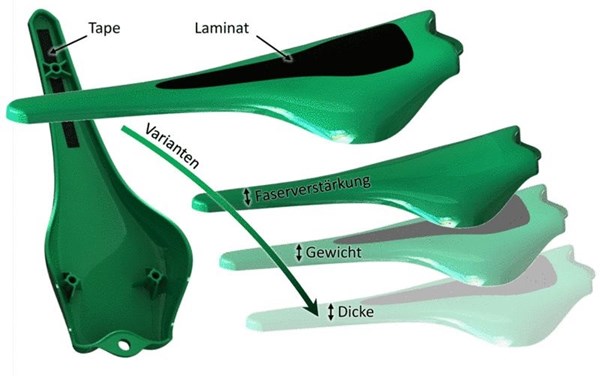Bicycle Saddle Can Be Locally Reinforced From One Shot to the Next
At K 2016, IKV to demonstrate production of a sports bicycle saddle molded from LGF-PP foams bolstered by UD laminates, with visitors able to personalize parts.
At K 2016, IKV to demonstrate production of a sports bicycle saddle molded from LGF-PP foams bolstered by UD laminates, with visitors able to personalize parts.
Once again, exciting developments can be expected as at every K show from the Institute of Plastics Processing (IKV) and the Skilled Crafts at RWTH Aachen University. With the aid of two production cells, IKV’s main research topics; namely, lightweight construction, additive manufacturing, Industry 4.0 and integrative plastics technology will be demonstrated live at Hall 14/C16.
With its 13 partners from different areas of the industry, IKV will demonstrate the implementation of Industry 4.0 in plastics processing via production cells customized for the production of foamed, continuous fiber-reinforced plastic hybrid parts. The entire production is networked in line with the principle of Industry 4.0 and reportedly allows continuous documentation from the input of the original order, via the production data to the subsequent quality assurance, which can be viewed by the respective customer.
A sports bicycle saddle which can be locally reinforced from one shot to the next, depending on the customer’s specs, is the demonstrator part in this project. The saddle is a molded long glass fiber reinforced polypropylene (LGF-PP) foam that can be optionally supplemented by unidirectional (UD) laminates on the top and underneath. The ProFoam technology used in this foam injection molding process is said to allow for gentle, stress-free processing of the LGF-PP. This reportedly makes it possible to attain large residual fiber lengths in the part.
In addition, it will be shown with the aid of the demonstrator how thermoplastic continuous fiber-reinforced laminates can be fully integrated automatically into the reproducible injection molding process. IKV says its approach allows the weight-specific mechanical properties of FRP materials to be combined with the automation potential of the injection molding process. As such, the economical use of the individually acting reinforcing inserts in injection molding will be demonstrated for the first time.
IKV is inviting visitors to actively control the production process and select a personalized part from the variants, and then have it made. The production parameters of shot volume, part thickness and type of fiber reinforcement can be varied from one shot to the next.
The project partners are: Arburg, ASS, Georg Kaufmann Formenbau, gwk, Hasco, HRS flow, IOS, Kistler, Krelus, Motan, SABIC, Sensopart and Staubli.

Related Content
-
Is There a More Accurate Means to Calculate Tonnage?
Molders have long used the projected area of the parts and runner to guesstimate how much tonnage is required to mold a part without flash, but there’s a more precise methodology.
-
Use These 7 Parameters to Unravel the Melt Temperature Mystery
Despite its integral role in a stable process and consistent parts, true melt temperature in injection molding can be an enigma. Learning more about these seven parameters may help you solve the puzzle.
-
Understanding the Effect of Pressure Losses on Injection Molded Parts
The compressibility of plastics as a class of materials means the pressure punched into the machine control and the pressure the melt experiences at the end of fill within the mold will be very different. What does this difference mean for process consistency and part quality?






